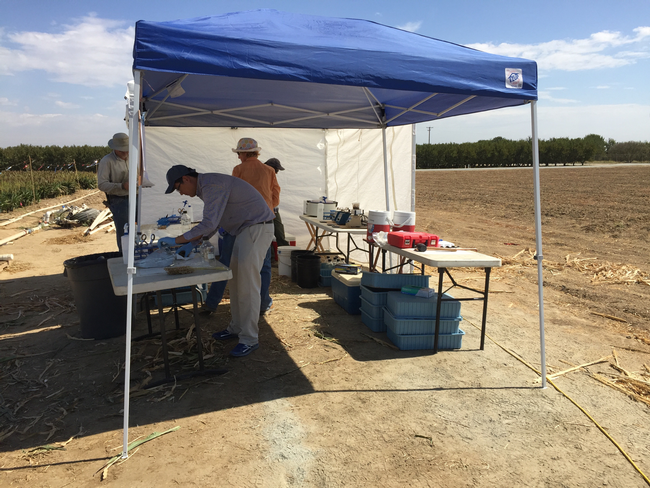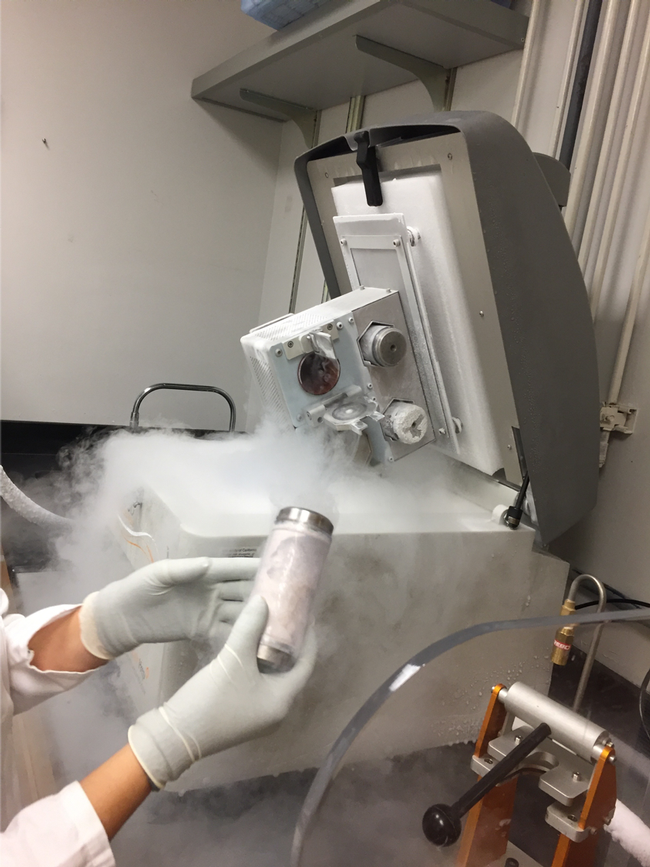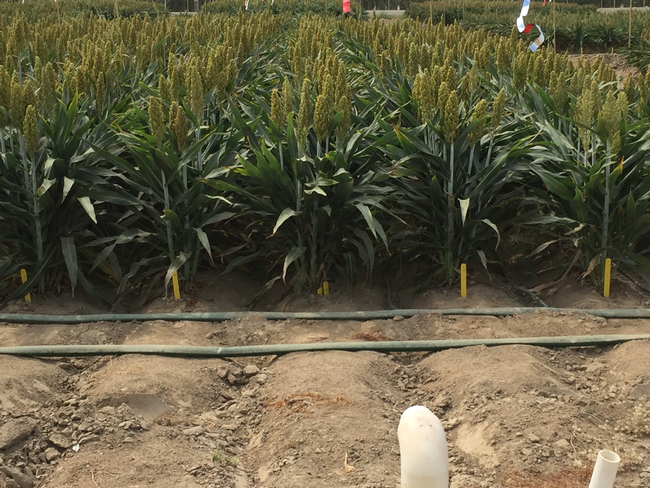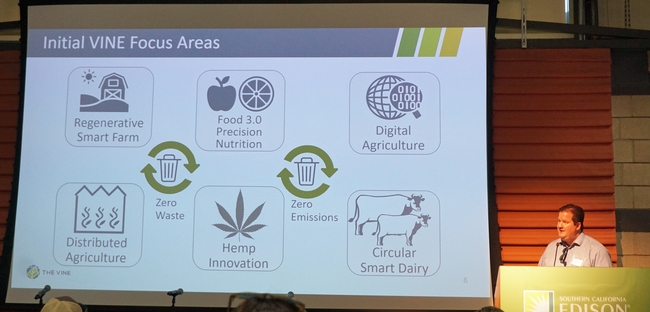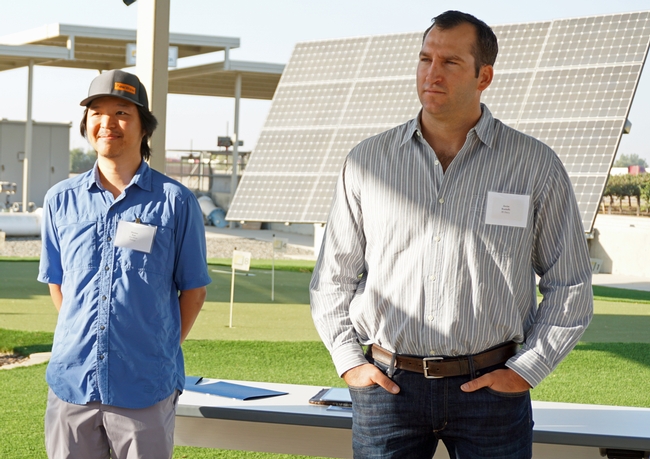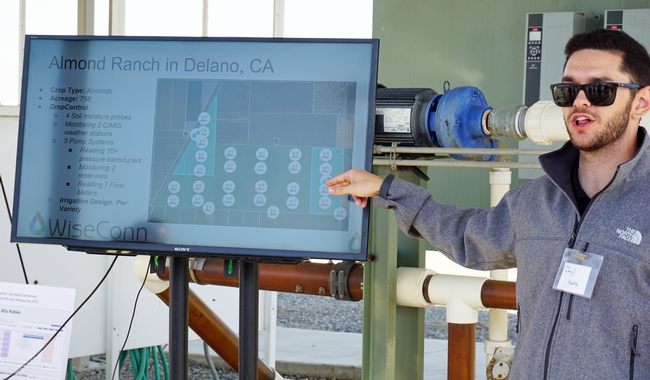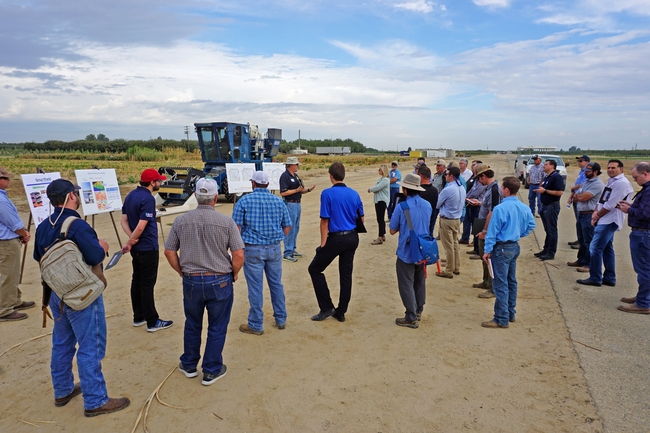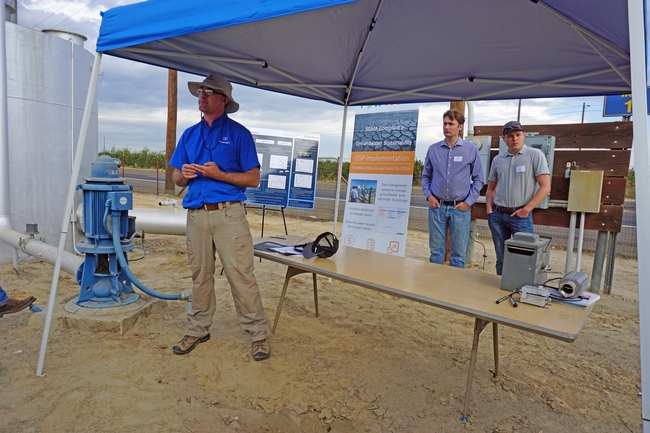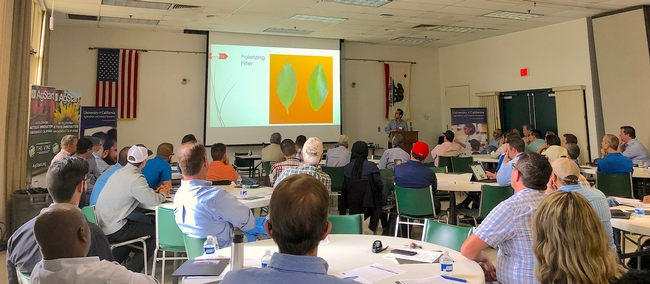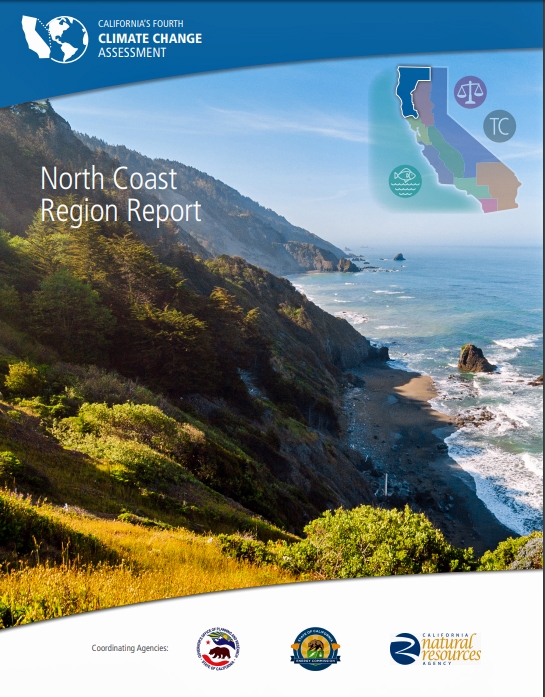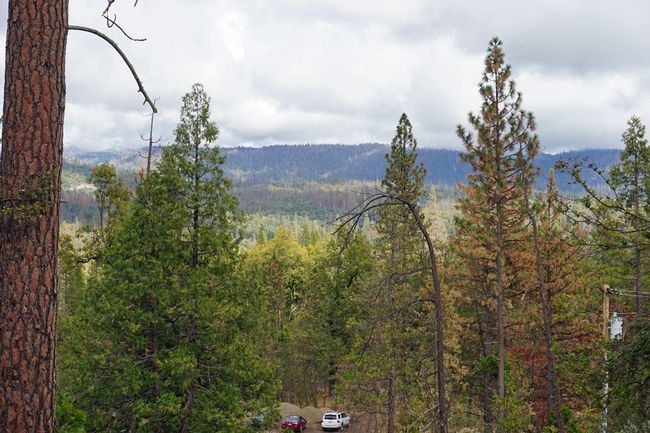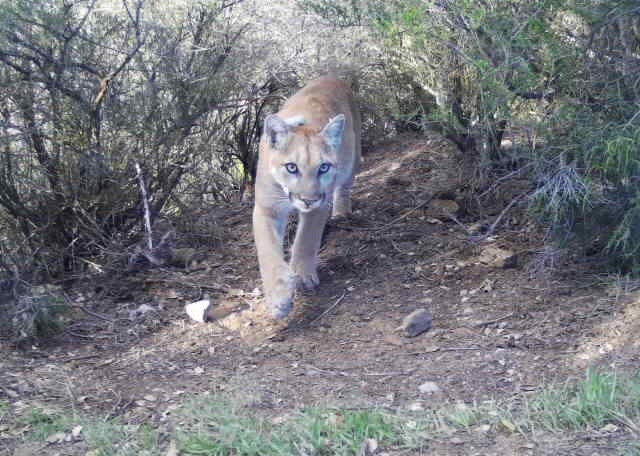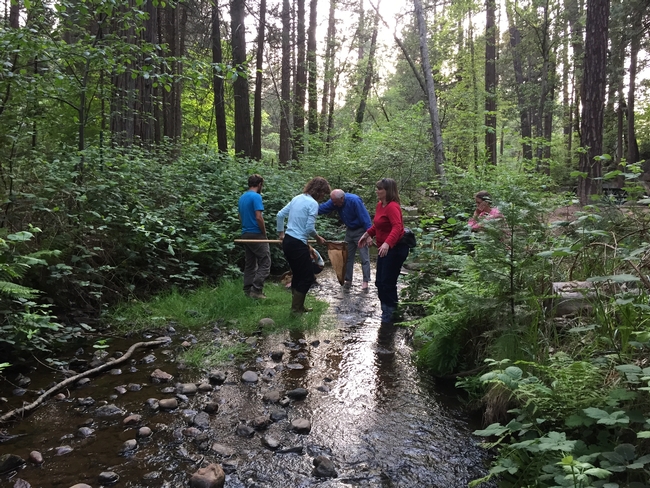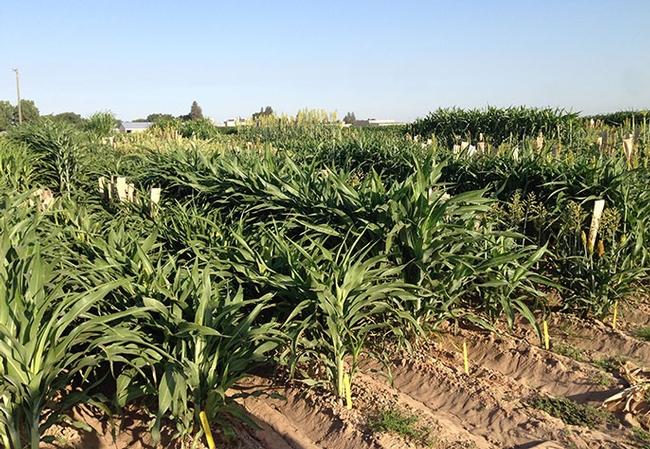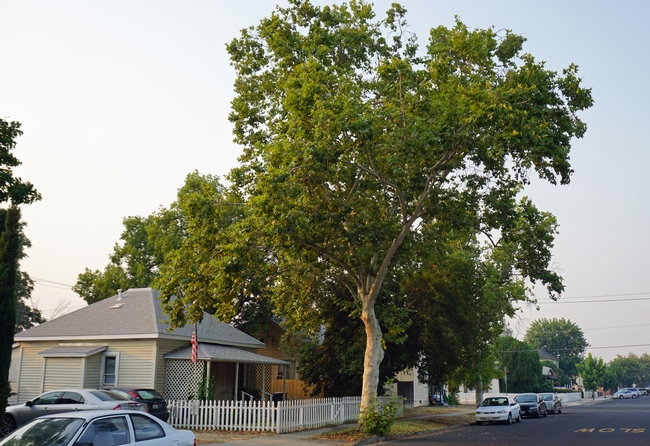Posts Tagged: Jeff Dahlberg
Genomic gymnastics help sorghum plant survive drought
Scorching temperatures and parched earth are no match for the sorghum plant — this cereal crop, native to Africa, will remain green and productive, even under conditions that would render other plants brown, brittle and barren.
A new study published this week in the journal Proceedings of the National Academy of Sciences provides the first detailed look at how the plant exercises exquisite control over its genome — switching some genes on and some genes off at the first sign of water scarcity, and again when water returns — to survive when its surroundings turn harsh and arid.
“With this research, we are laying the groundwork for understanding drought tolerance in cereal crops,” said Jeff Dahlberg, UC Cooperative Extension sorghum specialist. Dahlberg, co-author of the study, is also director the UC Kearney Agricultural Research and Extension Center in Parlier, one of nine research and extension centers in California that are part of UC Agriculture and Natural Resources.
Dahlberg said researchers can use the knowledge gained from this project to search for drought genes in other cereal crops.
“That has implications for feeding the world, particularly considering changing climate and weather patterns,” he said.
The massive dataset, collected from 400 samples of sorghum plants grown during 17 weeks at Kearney, reveals that the plant modulates the expression of a total of 10,727 genes, or more than 40% of its genome, in response to drought stress. Many of these changes occur within a week of the plant missing a weekly watering or after it is first watered after weeks of no precipitation or irrigation.
Kearney is a 330-acre agriculture research facility in the heart of California's Central Valley, where field-scale, real-world research can be conducted on drought impact on plants and soil microbial communities. The climate is naturally dry throughout the summer, making it ideal to mimic drought conditions by withholding irrigation water.
“People have really shied away from doing these types of experiments in the field and instead conduct them under controlled conditions in the laboratory or greenhouse. But I believe that the investment of time and resources that we put into it is going to pay off, in terms of the quality of the answers that we get, in terms of understanding real-world drought situations,” said Peggy Lemaux, UC Cooperative Extension specialist in UC Berkeley's Department of Plant and Microbial Biology and co-author of the paper.
To conduct the research, the team cultivated sorghum plants under three different irrigation conditions — pre-flowering drought, post-flowering drought and controlled applications of water — over three consecutive years at Kearney.
Each week during the growing season, members of the research team carefully harvested samples from the leaves and roots of selected plants and set up a mobile lab in the field where they could rapidly freeze the samples until they were processed for analysis. Then, researchers at JGI sequenced the RNA in each sample to create the transcriptome data, which reveals which of the plant's tens of thousands of genes are being transcribed and used to make proteins at particular times.
Finally, statisticians led by UC Berkeley statistics professor Elizabeth Purdom parsed the massive transcriptome data set to pinpoint how gene expression changed as the plants grew and were subjected to drought or relief from drought conditions.
“We very carefully controlled the watering conditions, and we sampled over the entire developmental timeframe of sorghum, so [researchers] could actually use this data not only to study drought stress, but also to study plant development,” Lemaux said.
The researchers noticed a few interesting patterns in the transcriptome data. First, they found that a set of genes known to help the plant foster symbiotic relationships with a type of fungus that lives around its roots was switched off in drought conditions. This set of genes exhibited the most dramatic changes in gene activity that they observed.
“That was interesting, because it hinted that the plants were turning off these associations [with fungi] when they were dry,” said John Vogel, a staff scientist at JGI and co-author of the paper. “That meshed well with findings that showed that the abundance of these fungi around the roots was decreasing at the same time.”
Second, they noticed that certain genes known to be involved with photosynthesis were also turned off in response to drought and turned up during drought recovery. While the team doesn't yet know why these changes might help the plant, they provide interesting clues for follow-up.
The data in the current paper show the plant's transcriptome under both normal conditions and drought conditions over the course of a single growing season. In the future, the team also plans to publish data from the other two years of the experiment, as well as proteomic and metabolomic data.
Nelle Varoquaux and Cheng Gao of UC Berkeley and Benjamin Cole of JGI are co-first-authors of the study. Other co-authors include Grady Pierroz, Christopher R. Baker, Dhruv Patel, Mary Madera, Tim Jeffers, Judith A. Owiti, Stephanie DeGraaf, Ling Xu, Krishna K. Niyogi, Devin Coleman-Derr and John W. Taylor of UC Berkeley; Joy Hollingsworth, Julie Sievert and Jeffery Dahlberg of UC ANR KARE; Yuko Yoshinaga, Vasanth R. Singan, Matthew J. Blow, Axel Visel and Ronan O'Malley of JGI; Maria J. Harrison of the Boyce Thompson Institute; Christer Jansson of PNNL and Robert Hutmacher of UC ANR.
This research was funded in part by the Department of Energy (DOE) grant DE-SC001408; the Gordon and Betty Moore Foundation grant GBMF3834; the Alfred P. Sloan Foundation grant
2013-10-27; L'Ecole NormaleSupérieure-Capital Fund Management data science chair and the DOE's Office of Biological and Environmental Research grant DE-SC0012460. Work conducted by the DOE JointGenome Institute is supported by the Office of Science of the DOE contractDE-AC02-05CH11231.
RELATED INFORMATION
- Dealing with Drought: Uncovering Sorghum's Secrets
- Berkeley to lead $12.3M study of crop drought tolerance
- Drought treatment restructures plants' microbiomes
- Microbes associated with plant roots could be a key to helping plants survive drought
Farming technology focus at Open Farm 2019
From robot vacuum cleaners and doorbell cameras to social media and e-commerce, technology is continually transforming lives and businesses. The world's oldest industry – agriculture – is no exception.
Remote sensors are all but eliminating the need for farmers to walk plant rows and make decisions based solely on observations, experience and intuition. New technologies that gather and analyze data can optimize crop needs, reduce environmental impacts, increase efficiency, cut energy costs and save water. The latest innovations were on display at the fourth annual Open Farm conference Oct. 23 in Tulare.
A demonstration by PowWow Energy showed artificial intelligence technology not only improving farming, but also spinning off new ideas and local businesses in rural communities. PowWow supports farms who have solar panels with information to optimize their return on investment. By monitoring weather, utility rates and meters, and the panels' energy generation, the company calculates precisely when energy losses caused by dust on the solar panels are valued higher than the cost of cleaning them. When it's time to wash the panels, farmers receive a text notification.
That got Tulare County dairy farmer Justin Roeloffs thinking about the growing need to efficiently clean dust from solar panels. He built a solar panel cleaning system that was so effective, he started a business – Roeloffs Solutions – to offer panel cleaning to other solar owners, creating new jobs in the farming community.
“The almond season is a disaster for solar panels,” Roeloffs said. “Some farmers buy a kit and do it themselves, but we had many calls for our service the first month in business.” Last summer, Roeloffs Solutions cleaned panels that generate 30 megawatts of power.
The founder of Concentric Power, Brian Curtis, explained the business he built to manage the energy usage and needs of large food processors, beginning in the Salinas Valley. The system allows businesses to save money on their energy bills, maximize the use of renewable energy and maintain reliable energy availability, even during blackouts and brownouts. Concentric Power combines wind, solar, co-generation and battery storage to develop a company's own micro-grid.
“The recent public safety power shutoffs are ringing our bell,” Curtis said. “The stars have aligned for us.” So far three Salinas Valley food processors and one in Bakersfield have installed the micro-grid systems. Curtis said energy intensive ag industries – such as dairies, cheese processors and wine producers – are potential clients.
A variety of other automation solutions were also shared at Open Farm:
- Darryl Hadlich of WiseConn said the company's precision irrigation timing system – monitored by infield sensors and controlled by in-field nodes – allows farmers to schedule, start and end irrigation and fertigation using their cellphones or desktop computers. The associated software also shows when energy companies offer lower, off-peak rates to enable irrigation scheduling when the cost to operate the pump will be at its lowest.
- Conner Kingman of Kingman Ag Service is perfecting technology to reconfigure the tractors farmers already own with artificial intelligence-aided computers to pull a wide variety of farm implements through the field, such as a spring tooth cultivator, mower, shredder and sprayer. The driverless tractors reduce labor needs, and enable farm work to continue around the clock without breaks or worker safety concerns.
- Jose Baer at PowWow Energy detailed programmable irrigation systems for small and large farming operations. The field is monitored with aerial images and uses data from in-field sensors for targeted water application.
- John Cardoza of Sustainable Conservation explained a collaborative research project that studied methods for dairy wastewater management using sensors, sand media filters and drip irrigation. In the study, nitrous oxide emissions were cut by 70%, water use by 36% and nitrogen applications by 45%.
During a researcher and industry panel on the state of technology integration from the grower's perspective, participants reflected on how technology will help prepare for the future. The panel was moderated by Dennis Donahue, director of Western Growers Center for Innovation and Technology:
- Director of the Tulare County Resource Conservation District Mike Chrisman, a long-time Tulare County farmer, noted that data will be increasingly critical for farming as California agriculture enters the Sustainable Groundwater Management Act era in 2020. The law requires that California groundwater usage be “sustainable” by 2040 – meaning that the amount that is drawn out must match the amount that is recharged. “This will change the way we all do business,” Chrisman said. “Agriculture in 20 years won't look like it looks today.”
- Jeff Dahlberg, director of the UC Kearney Agricultural Research and Extension Center and a sorghum extension specialist, said high technology companies will rely on UC researchers to confirm that their products are meeting expectations. UC scientists can contribute by applying their knowledge on plant growth and development. “We understand biology and how plants use water,” he said. “We will be asked to ground truth technology.”
The event is a collaborative effort by UC Agriculture and Natural Resources, Fresno State's BlueTech Valley, the California Energy Commission, PowWow Energy, West Hills College and the Western Grower Center for Innovation and Technology. Open Farm 2019 was hosted at the Southern California Edison Energy Education Center.
UC research could help farmers face droughts worldwide
Sorghum is not only a potential drought-tolerant crop for the San Joaquin Valley, it also presents the opportunity for scientists to understand the mechanism behind drought tolerance at the genetic level, said UCCE sorghum specialist Jeff Dahlberg in a segment on ABC 30 Action News.
Reporter Cristina Davies spent an hour and a half at the UC Kearney Agricultural Research and Extension Center in Parlier during the sorghum harvest to learn about the potential of sorghum research.
"If we can elucidate the genetics behind (drought tolerance), what we believe is we can use those genetics to see if the genetics are available in corn, or in rice, or in wheat," Dahlberg said. "I think the genes may be there. We just don't have the tools yet to search for the genes in those crops."
Conducting drought-tolerance research in California is ideal because the summer is typically devoid of rain. Researchers can control exactly how much water is applied to each sorghum plot. The research has revealed more than 100 genetic markers that may confer drought tolerance.
"We've been really thrilled with the data that's been coming out of this. Like most research, we are learning so many things we don't understand," Dahlberg said.
The research is being conducted in collaboration with the USDA's Agricultural Research Service research center, which is across the street from Kearney. USDA research scientist Devin Coleman-Derr was present for the sorghum harvest.
"Like humans take probiotics, there may be a use for microbes in sort of promoting better and better yields in the field," Coleman-Derr said.
The 330-acre UC Kearney Agricultural Research and Extension Center is the University of California's largest off-campus agricultural research facility.
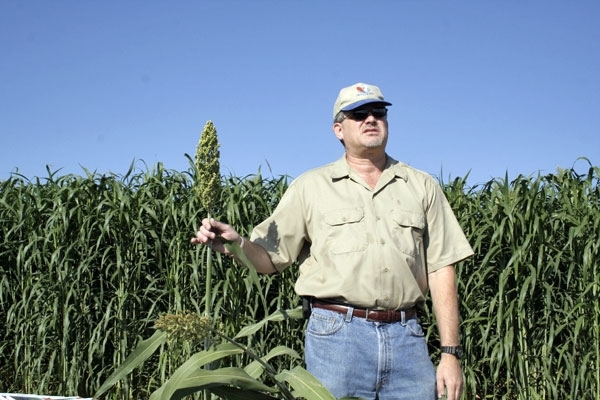
UCCE specialist Jeff Dahlberg studies sorghum at the UC Kearney Agricultural Research and Extension Center in Parlier.
Open Farm 2018 and UC ANR promote ag technology
A torrent of technology is flowing into the agricultural sector. To make sense of it, UC Agriculture and Natural Resources, Fresno State and West Hills Community College came together with technology vendors and growers at Open Farm 2018, held in October at UC ANR's Kearney Agricultural Research and Extension Center in Parlier.
“A lot of technology is coming out,” said Kearney director and UC Cooperative Extension agronomy specialist Jeff Dahlberg. “I need to caution you, it's not all is based on science. We are helping with testing.”
Dalhberg has been working with Blue River Technologies to monitor the growth of dozens of sorghum cultivars. Throughout the growing season, Blue River flew drones over the sorghum nursery with cameras to capture their growth and development.
“We have a huge phenotypic dataset,” Dalhberg said. “It will be compared at the genetic level with plant samples and help us identify genes associated with drought tolerance.”
At Open Farm, Dahlberg's field presentation was paired with Smartfield, a company that uses fixed cameras and field sensors to gather information for “big data crunching.”
PowWow Energy, based in San Francisco with a field office at the Water, Energy and Technology (WET) Center at Fresno State, met near a well at Kearney to explain how the company can help growers with decision support tools. The company believes their technology will be useful for farmers tracking groundwater usage, data that will be key to complying with new rules associated with the Sustainable Groundwater Management Act (SGMA). SGMA, signed by Gov. Brown in 2014, gives local agencies the authority to manage groundwater in a way that achieves sustainability by 2042.
UCCE agriculture mechanization specialist Ali Pourezza introduced a prototype he developed with junior specialist German Zuniga-Ramirez that he believes will make early detection of the devastating citrus disease huanglongbing as easy as taking a photo with a smartphone camera.
The idea is based on the optical characteristics of the disease in leaves. By using a polarizing light, leaves on diseased trees are immediately identified. Infected trees can then be torn out before insects have the chance to spread the disease to other trees.
Pourezza and Zuniga-Ramirez are seeking funding to take the prototype to the next level, and eventually commercialize the product.
This sampling of innovations being showcased at Kearney is part of a continuing effort by UC to connect the ag community with technology developers and resources that is shepherded by a new UC ANR program called The VINE, Verde Innovation Network For Entrepreneurship. The VINE was created by UC ANR in 2017 to link entrepreneurs with mentors, advisors, collaborators, events, competitions and education.
At Open Farm 2018, UC ANR vice president Glenda Humiston was the keynote speaker. She outlined three areas where farmers, the technology sector and academia can work together to accelerate technology application in rural parts of California: improve broadband access, identify high-value uses for biomass and establish water infrastructure in rural communities.
To address the broadband issue, Humiston is leading an initiative to document mobile internet speed across California – including rural areas. In April 2019, Humiston plans to enlist 4-H members across the state to test internet speed using the free smartphone app CalSpeed several times over a period of a week.
“This will give us a snapshot of mobile broadband service availability,” Humiston said.
The crisis in the Sierra Nevada – where millions of trees died from the drought of 2010-16 – could prompt the development of high-value uses of biomass and establish a market for biomass derived in the agricultural sector, she said.
Humiston also took the opportunity to ask participants to help make sure the critical services UC ANR provides – including county-based UC Cooperative Extension, nine research and extension centers, the UC integrated pest management program, 4-H youth development, UC Master Gardeners and others – continue to fuel the California economy. Diminished funding from the State of California is taking a toll on the UC ANR budget.
“We need people like you to work with the VINE to set up improved support,” Humiston said.
UC Cooperative Extension works in local communities to help Californians adapt to climate change
Californians received bleak news last month when the state released its fourth assessment of climate change in California. The report predicts severe wildfires, more frequent and longer droughts, rising sea levels, increased flooding, coastal erosion and extreme heat.
“It's great to be living in a state where science and facts around climate change are valued,” said UC Cooperative Extension specialist Adina Merenlender, “but the recent forecasts may make you want to devour a quart of ice cream in a pool of salty tears.”
Modern civilization has changed the world climate, and even dramatic reductions in global greenhouse gas emissions at this point won't turn back the clock. The warming now predicted by Cal-Adapt is likely already “baked in,” even with our best mitigation efforts, said Igor Lacan, UC Cooperative Extension advisor in the Bay Area of California.
California has been a leader in facing the future climate head on. The state's first comprehensive assessment on climate change was produced in 2006 under then-Gov. Arnold Schwarzenegger. The second assessment, released in 2009, concluded that adaptation could reduce economic impacts of loss and damage from a changing climate. The third assessment was shaped by a request for more information on the adaptation options in the 2009 report. The fourth assessment was the first effort to break down global climate predictions and their impacts onto specific regions of California.
Author of the North Coast Region Report of the Fourth Assessment, Ted Grantham, praised state leaders for pushing forward efforts to slow climate change and adapt to the new weather conditions expected in California.
“California is playing a unique role in filling the void of leadership on this issue that the federal government was beginning to address under the Obama administration,” Grantham, a UC Cooperative Extension specialist based at UC Berkeley, said.
Across California, UC Cooperative Extension specialists and advisors are working in their local communities to prepare for warming temperatures and adapt to the changing climate. Following are examples of the efforts now underway.
Managing forests to survive the future
Among the suggested adaptation strategies in the 81-page North Coast Region Report, written by Grantham and his colleagues, the authors encourage government agencies and private forest owners to use prescribed fires and active forest management to reduce an overgrowth of trees and shrubs that fuel the more frequent and intense fires expected in the future.
Although climate change will create conditions conducive to catastrophic wildfire, the reason for dangerous forest overgrowth is related to decades of fire suppression on the landscape.
“Our forests are much denser and have more fuel buildup than they would have under a natural fire regime,” Grantham said. “Mechanical thinning, removing wood from the landscape and prescribed fires can help limit the impacts of wildfire.”
Native American tribes are being tapped to share their traditional ecological knowledge to inform this practice.
“Native Americans have used fire since time immemorial to manage their landscapes,” Grantham said.
Connecting habitats to allow species movement
When climate changes, plant and animal species may find their current habitats no longer fit the environment where they evolved. The fourth assessment technical report, Climate-wise Landscape Connectivity: Why, How and What Next, written by UCCE specialist Adina Merenlender, documented potential techniques to erase barriers to plant and animal movement.
“When we talk about wildlife corridors today, we might view a road as a barrier,” Merenlender said. “With climate change, the movement is over a much longer range for species to find suitable habitat at the end of the century.”
The report says research is needed to compare different approaches to designing climate-wise connectivity, determining how wide corridors need to be, and quantifying the impact of natural and anthropogenic barriers on possible range shifts.
California's wine industry is based on international varieties that come from Northern France, where the climate is cool, mild and consistent.
“They really require a cool to warm climate, not a hot climate,” said Glenn McGourty, UCCE viticulture advisor in Mendocino County.
There are many wine grape cultivars from Southern Europe – areas in Italy, Portugal and Spain – that are adapted to heat and make quality wines, but aren't well known. The varieties include Monepulciano, Sagrantino, Periquita and Graciano.
McGourty is studying how these cultivars perform in the warm interior of Mendocino County at the UC Hopland Research and Extension Center.
“We have many options as climates warm in the interior part of California to make wine that needs less amelioration in the winery compared to cultivars from Northern France,” McGourty said.
Recruiting and training climate stewards
The UC California Naturalist Program is moving full steam ahead with a new Climate Stewards Initiative to build engaged communities and functioning ecosystems that are resilient to changing climates.
California Naturalist, with trained volunteers across the state working with myriad conservation organizations, will be using its educational network to improve the public's understanding of climate change and engage the public in community action and local conservation.
“Climate stewards will offer in-person communication with your neighbors, tapping into science,” Merenlender said. “Improving climate literacy is an important outcome, but that won't happen through a website.”
Helping growers modify farming practices due to changing climate
USDA Climate Hub has awarded a grant to UC Cooperative Extension to support tools to assist growers in making strategic decisions in season and long term.
“We have many credible sources of weather and climate data, but often times we are challenged with translating it into decision support tools tailored to growers' needs,” said Tapan Pathak, UCCE specialist in climate change adaptation in agriculture. “It's too early to say which specific tools we will develop, but we are aiming to help farmers use weather and climate information in decision making processes.”
Pathak is also working with colleagues to analyze how generations of navel orangeworm, a significant almond pest, might shift for the entire Central Valley under climate change and how growers can adapt their practices to manage the higher pest pressure.
Using epigenetics to impart drought tolerance
At the UC Kearney Agricultural Research and Extension Center in Parlier and the UC West Side Research and Extension Center in Five Points, sorghum nurseries are being grown under drought and well-watered conditions to compare the environmental impacts on the plants' gene expression.
“We hope to tease out the genetics of drought tolerance in sorghum,” said Jeff Dahlberg, UCCE specialist, who is managing the trials at Kearney. “Using sorghum as a model, we expect this research to help us understand drought tolerance in other crops as well.”
Historically, the genetic manipulation of crops, which has been critical to increasing agricultural productivity, has concentrated on altering the plant's genetic sequence, encoded in its DNA.
Recent studies have shown that environmental stresses – such as drought – can lead to epigenetic changes in a plant's genetic information. Because epigenetic changes occur without altering the underlying DNA sequence, they allow plants to respond to a changing environment more quickly.
Cities can plant street tree species suited to future climate
Many common street trees now growing in the interior of California are unlikely to persist in the warmer climate expected in 2099, according to research published in the July 2018 issue of the journal Urban Forestry & Urban Greening. (Read the research report here until Sept. 27, 2018)
“Urban foresters in inland cities of California should begin reconsidering their palettes of common street trees to prepare for warmer conditions expected in 2099 due to climate change,” said the study's co-author, Igor Lacan, UC Cooperative Extension environmental horticulture advisor in the Bay Area.
Common trees in Coastal California cities appear to be better suited to withstand the 2099 climate.
“Our research shows that some trees now lining the streets of cities like Fresno, Stockton and Ukiah are likely to perform poorly in 2099,” Lacan said. “Those cities need to look at the conditions – and trees – now found in El Centro, Barstow and Fresno respectively.”
Trees to shade California in a warmer future
The changing climate predicted for California – including less rain and higher day and nighttime temperatures – is expected to cause chronic stress on many street tree species that have shaded and beautified urban areas for decades.
Realizing that popular trees may not thrive under the changing conditions, UC Cooperative Extension scientists are partnering with the U.S. Forest Service in a 20-year research study to expand the palette of drought-adapted, climate-ready trees for several of the state's climate zones.
“The idea is to look at available but under-planted, drought-tolerant, structurally sound, pest resistant trees for Southern California that do well in even warmer climates,” said Janet Hartin, UCCE horticulture advisor in San Bernardino County.
Twelve tree species were selected for each climate zone in the comparative study, with several area parks used as control sites.
Managing the forest for survival in warmer conditions
UC Cooperative Extension scientists are part of a collaborative research project with the University of Nevada, Reno, CAL FIRE and the U.S. Forest Service aimed at developing new strategies to adapt future forests to a range of possible climate change scenarios in the Sierra Nevada.
“It includes the idea that we may be struggling just to keep forests as forests, let alone having the species we value,” said Rob York, manager of UC Berkeley's Blodgett Forest Research Station near Georgetown.
Forests sequester a tremendous amount of carbon. As the climate changes, foresters will need to be proactive to reduce the risk of these massive carbon sinks becoming carbon sources.
“We're working to mitigate predicted impacts to forests, including regeneration failures, drought mortality and catastrophic wildfire,” Ricky Satomi, UCCE natural resources advisor in Shasta County.
At three separate study sites across the Sierra Nevada, novel approaches to forest management are being implemented to develop treatments that scientists believe will increase resilience, resistance and adaptability of Sierra Nevada mixed conifer forests.
The 2018-21 project is led by Sarah Bisbing, forest ecology professor at the University of Nevada, Reno, and funded with $2.7 million from CAL FIRE.
Climate change impacts on vulnerable communities
The latest climate assessment also reports on the serious nature of climate threats to vulnerable communities and tribal communities in California, with a focus on working collaboratively with these communities on research and solutions for resilience.
“The impacts of climate change will not be experienced equally among the population,” Grantham said. “The most significant public health and economic impacts – from flooding, extreme heat, air quality degradation, etc. – will be disproportionately experienced by vulnerable populations, including people of color, the poor and the elderly.”
The assessment includes a Climate Justice Report, which shares the idea that no group of people should disproportionately bear the burden of climate impacts or the costs of mitigation and adaptation. The report suggests collaborating with these communities on research and solutions for resilience.

